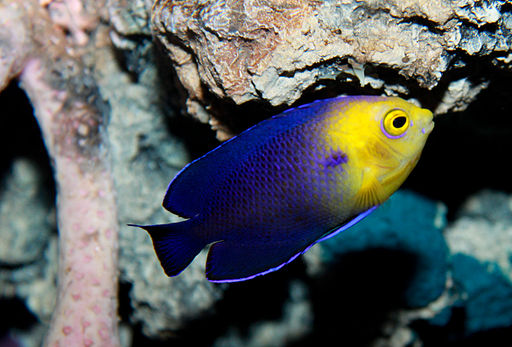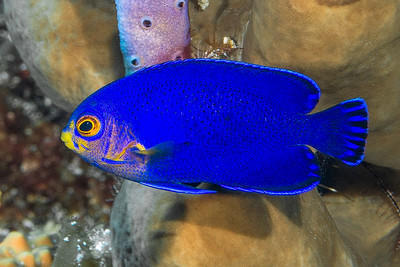Pygmy (Cherub) Angelfish: Care, Diet, Tank Mates & More
Posted by on 4/01/2023
If you're looking for a small fish that packs a punch, look no further than the Pygmy Cherub Angelfish. The fish has earned quite a few common names over the years. Cherubfish, Atlantic Pygmy, and Cherub Angelfish, but it's most commonly referred to as the Pygmy Angelfish.
In this post, we'll cover everything you'll need to know before choosing a Pygmy Angelfish as the next addition to your saltwater aquarium.
Table of Contents
January's Giveaways on Light Fish
Species Summary
In the wild, the Pygmy Angelfish (scientific name: Centropyge argi) can be found swimming off the coasts of North Carolina, Bermuda, the Gulf of Mexico, and as far south as Guyana. The fish is a member of the Pomacanthidae family, which contains other popular aquarium fish, such as the Royal Angelfish, Koran Angelfish, and other Centropyge species, including the rare Peppermint Pygmy Angelfish.
These fish live in harems, where a dominant male is surrounded by multiple females. Similar to other species of marine fish, Pygmy Angelfish are born as females, and transition to males when an opportunity presents itself to become the dominant fish. Interestingly, they're also capable of reversing their sex if needed.
The species is known for its shy personality, and dwells between 15 and 60 feet below the ocean's surface. A known omnivore, the species feeds primarily on small crustaceans and different types of algae.

Appearance
The Pygmy Angelfish is a stunning marine fish and shares a similar coloration as the related Japanese Angelfish (scientific name: Centropyge interruptus). The Pygmy Angelfish features a yellow-colored face that transitions to a deep royal blue near its pectoral fins. The fish's caudal, anal, and dorsal fins are accented by an electric blue coloration, and the fish's black eye is surrounded by a bright blue ring.
When examined closely, the body of the fish features a scale-like pattern, and the ends of the fish's tail fin feature bright blue, horizontal lines.

Male vs Female
Male and female Pygmy Angelfish do not have any differences in appearance. Gender can only be identified when the fish are kept together in a small group. Due to their harem-based social hierarchy, there will only be one male in a group, the rest will be female. In most cases, the male will be the largest.
Pygmy Cherub Angelfish vs Pygmy Yellowtail Angelfish
Another Angelfish that's received the "Pygmy" common name is the Pygmy Yellowtail Angelfish (scientific name: Centropyge flavicauda). Hobbyists looking to distinguish the Pygmy Cherub from the Pygmy Yellowtail should examine the tail and body coloration. Pygmy Yellowtails have a dark violet, almost black coloration, with translucent yellow tails. The Cherub Angelfish has an opaque royal blue body and tail.
Size
An adult Pygmy Cherub Angelfish will grow to reach about 2.5 inches in length.
This species is quite small, making it an excellent choice for hobbyists with smaller tanks. In many cases, the males are typically about half an inch larger than the females.
Growth Rate
The Pygmy Angelfish should grow half an inch every 4-5 months until they reach their adult size at about 2 years of age.
Providing a nutrient-rich diet combined with daily feedings will result in the healthiest growth rates.
Pygmy Angelfish Care
If you're interested in acquiring a Pygmy Angelfish, you'll want to have a good understanding of the fish's care requirements.
While the fish isn't the most difficult to keep, it does have an aggressive personality and dietary demands that make it better suited to the more experienced hobbyist.
Lifespan
When provided a well-balanced diet and pristine water conditions, the Pygmy Angelfish should live for about 5 years in captivity.
Pygmy Angelfish can stress easily, so it's important to select suitable tank mates while providing them with plenty of hiding spots. Providing the Pygmy Angelfish with a high-quality diet will keep them well-fed while aiding in disease prevention.
Tank Size
Pygmy Angelfish should be added to an aquarium no smaller than 55 gallons in size.
Although these fish are quite small, they require a large amount of live rock which they'll use to hide in when frightened. Hobbyists looking for a nano aquarium fish should look towards other species, such as the Pink-Streaked Wrasse or Orange Spotted Goby.
Acclimation
Hobbyists should acclimate their fish by aligning the temperature and salinity levels of the fish's transport bag with that of their display tank.
If salinity levels are within .002, the transport bag can be floated directly in the display tank for 30 minutes, after which the fish can be released into the aquarium or an acclimation box .
If salinity levels differ by more than .002, you'll want to perform drip acclimation with airline tubing or a drip acclimation kit .
Water Conditions
Pygmy Angelfish can be found in the western Atlantic Ocean, and you'll want to recreate the water conditions of their natural habitat as closely as possible in an at-home marine aquarium.
Aim for the following:
Specific Gravity: 1.020-1.025
Temperature Range: 72°F-78°F
dKH: 8-12 dKH
pH: 8.1-8.4
Ammonia: 0ppm
Nitrite < .2ppm
Nitrate < 10ppm
Maintain these parameters for the entirety of your Pygmy Angelfish's life to improve the chances they'll reach their full life expectancy.
Tank Setup
The most important part of setting up a tank for a Pygmy Angelfish is providing them with plenty of live rock. These fish will appreciate the small caves and crevices created by live rock, and will view the caverns as areas of refuge at night or if they get spooked during the day.
In terms of equipment, a sump combined with an optional refugium is recommended. These pieces of aquarium equipment increase the total amount of water volume in an aquarium ecosystem, reducing the tank's vulnerability to sudden swings in water chemistry.
Pygmy Angelfish aren't very picky when it comes to flow rates, and a reputable sand substrate will work well with the species.
Common Diseases
Pygmy Angelfish are susceptible to the same diseases that affect most marine aquarium fish. Luckily, these fish don't have the thin slime coats we see in tangs, such as the powder blue, making them a bit more resistant to parasites and other forms of bacteria.
Still, it's important to quarantine affected fish immediately, and we strongly recommend quarantining any future tank additions. Some of the most commonly seen marine diseases are marine velvet and ich. We cover the topic in more detail in another one of our blog posts Marine Velvet vs Ich: Similarities, Differences, Causes & Treatment.
Food & Diet
Pygmy Angelfish should be fed a diet consisting of Mysis shrimp, brine shrimp, spirulina, nutrient-rich flake, pellet food, and Nori 3 times a day.
Pygmy Angelfish aren't very picky when it comes to food, and will also readily graze on any available algae present in the aquarium. There have also been reports of them picking at pineapple sponges.
Behavior and Temperament
Pygmy Angelfish tend to exhibit curious and skittish personality traits. Immediately after being introduced into an aquarium, they'll tend to be a bit shy but will grow more confident after a few months have passed.
The species will display aggression towards other Centropyge species, and males will show extreme levels of aggression towards other Pygmy Angelfish males (and will even fight to the death.) However, they're incredibly peaceful towards other marine fish, as well as females of their own species.
They're quite active once they've established themselves, and will frequently swim around the tank in search of new food sources or algae to graze upon.
Reef Compatibility
Hobbyists looking to add a Pygmy Angelfish to their existing reef tank should proceed with caution. They're known to pick at Acans and other LPS corals, such as Candy Canes, Blastos, and Torches.
Aquarists comfortable with risking their corals should stay on top of regular feedings. Keeping a Pygmy Angelfish well-fed will reduce the chances that they'll nip at corals in a reef aquarium.
However, Pygmy Angelfish will tend to avoid Anemones, such as the Black Widow. In an aquarium where an anemone is hosted by a clownfish, the odds of a Pygmy Angelfish picking at an anemone are even further reduced, as the clownfish will actively guard their hosted anemone.
Tank Mates
Due to their aggressive personalities, there should only be one Pygmy Angelfish male kept in an aquarium. Outside of male-to-male aggression, they're quite peaceful and can co-exist comfortably with other marine fish that demonstrate a peaceful temperament.
Tank mate options for the Pygmy Angelfish Include:
Pygmy Angelfish can co-exist with tangs, such as the Powder Blue, Gem or Blonde Naso, but you'll need to provide a large enough aquarium and introduce all of the fish at once.
Avoid highly aggressive species, such as the Tessalata Eel, or other male Pygmy Angelfish.
Breeding
Pygmy Angelfish have been successfully bred in captivity. We've seen captive-bred offerings from Biota, but there is limited information documenting the process in detail. Raising Pygmy Angelfish fry is a difficult endeavor, as you'll need to provide a diet consisting of wild-collected zooplankton - a dietary requirement that is often difficult to acquire.
Hobbyists looking to breed the species will first need an established, dedicated breeding tank, something in the 25-50 gallon range will suffice. Temperatures should be raised slightly, and kept between 78-80°F.
Next, you'll need a successful male/female pair-up. This will be a challenging initial step, as the males and females are visually indistinguishable. You'll likely need to purchase a group of fish and establish a harem, where there is one male with many females. Males will show high levels of aggression towards one another and should be immediately removed.
Once a harem is established, the male will begin to court a female, by performing what's known as a signal jump, a swimming maneuver in which the male will swim towards the surface, and then back down towards the substrate in an arc-like motion.
Spawning should occur regularly and tends to occur once the aquarium lights in the breeding tank have gone off. Pygmy Angelfish are an egg-laying species and will lay hundreds of buoyant eggs at a time.
After two weeks have passed, the eggs will begin to hatch into fry. Raising the fry is the most difficult step in the breeding process, very few will reach the juvenile stage. Water conditions must remain immaculate (10% semi-daily water changes), and the fry must be fed a diet consisting of wild-collected live zooplankton.
After a few weeks have passed, any remaining fry should transition to a diet of chopped-up, nutrient-rich pellet food.
Continue to perform 10% semi-daily water changes over 8 weeks. If successful, the fry will have transitioned into juveniles and can be fed chopped-up portions of their adult diet.
Where to Purchase
Pygmy Angelfish can be found for sale on our marketplace and are also sold by some of the larger online vendors, including LiveAquaria and Biota.
These fish tend to be quite affordable and typically sell between $25-$75.
We strongly recommend quarantining any new Pygmy Angelfish after purchase and also recommend inquiring about the age and water conditions of any new tank additions.
In Conclusion
As you can see, what the Pygmy Angelfish lacks in size, it makes up for in appearance and personality. This unique-looking species is an excellent choice for hobbyists looking to acquire an angelfish without breaking the bank. While they do require a moderately sized aquarium, these active fish make a great addition to a marine aquarium.
Now that we've discussed the species in detail, do you plan on adding one to your saltwater tank? Let us know in the comments, and be sure to check out our marketplace, where you can buy and sell aquarium fish with other hobbyists.
January's Giveaways on Light Fish


